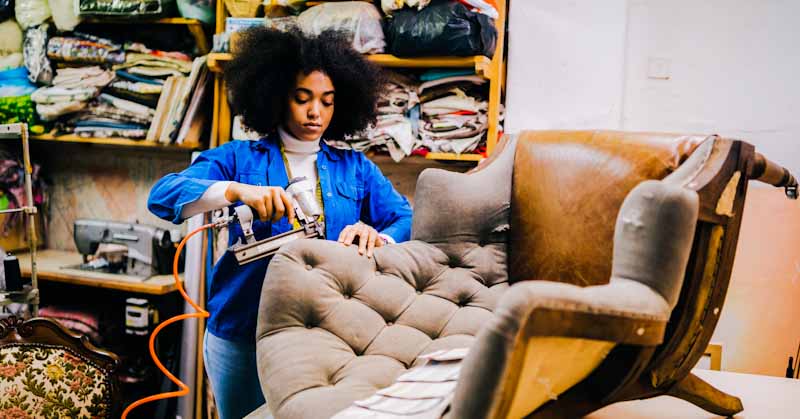How configuration is shaping the furniture industry
blog
December 19, 2023Consumers are looking for more ways to make furniture their own - and brands can win big by providing configuration at scale.
Not so long ago, consumers had a distinct choice when choosing furniture for their home or workplace. Larger furniture brands and manufacturers offered showrooms with plenty of choice but limited scope for customization. Smaller boutique brands would offer less choice but more opportunities to get pieces designed for unique needs and tastes.
However, the lines between these two options are becoming increasingly blurred. Indeed, in a sign of shifting market appetite, a recent study by Deloitte reported that 42% of customers prefer to purchase furniture from companies that offer them customization options. This heightens the need for furniture brands of all sizes to put configuration front and center of their thinking.
In a crowded and competitive market, the ability to offer more personalization is becoming a big differentiator among brands and manufacturers. Configuration at scale is a powerful tool to drive sales, increase brand engagement, and provide market-leading customer experiences. But how can large-scale manufacturers offer the same personalization agility as smaller brands? With the right PIM software as their foundation. Let’s find out how.
New methods of customization by furniture brands
The trend towards higher configurability in furniture is driven primarily by the evolving preferences of consumers. Increasingly, whether they’re buying for their home or workplace, people want furniture that aligns with their tastes, lifestyle, or brand. To meet this demand, furniture manufacturers and retailers are transforming the way they operate.
There are a few key areas that furniture brands are focusing on when it comes to customization. To see how this works in practice, let’s look at a brand-new sofa:
Customization and tailored solutions
Furniture brands and manufacturers are offering significantly more customization options when it comes to the look, feel, and size of their sofas. This allows customers to personalize their sofas in terms of design, materials, colors, and dimensions. With this type of personalization, customers are much more likely to be satisfied with their purchases. They’re also a lot less likely to return the sofa once they have it home.
Product innovations
Furniture manufacturers are also introducing more innovative product lines to meet increasingly diverse consumer needs. Often, these innovations are marketed as additional extras to the standard option; extras that can be customized to the buyer’s needs. For example, when it comes to the sofa, these innovations could be anything from improved modularity and internal storage to cup holders and even built-in drinks fridges.

Sustainability
As well as design and aesthetics, consumers want a say over the materials used in the pieces they buy. When it comes to the sofa, choosing bamboo as the main material is just one example of a more sustainable design choice. As such, furniture manufacturers are increasingly prioritizing eco-friendly practices when it comes to materials and production processes. Brands that create compelling product origin stories to demonstrate how they help consumers live sustainably can position themselves as industry leaders over the coming years.
Enhanced digital engagement
It’s not just the product itself that can be customized. An increasing number of furniture brands are taking advantage of new technologies to personalize buying experiences, too. Once customers have decided on a sofa, virtual reality (VR) and augmented reality (AR) can help them get a clearer picture of how they will fit into their living space. As well as bringing the ‘wow’ factor to the buying journey for the sofa, the use of these cutting-edge technologies also eliminates the customer’s worry that the sofa will be too big (or too small) for their space.
The role of PIM in driving personalization
Understanding the ways that the furniture buying journey can be customized is one thing. Being able to introduce personalization at scale is something else entirely. That’s why so many of the leading furniture brands and manufacturers rely on Product Information Management (PIM) software to meet the complex and diverse needs of a fully scalable configuration offering. Here are some of the key ways an advanced PIM solution can help furniture brands unlock the potential of configuration.
Limitless support for complex configuration options
Advanced PIM software powered by a fully extensible data model enables furniture brands to manage and showcase a wide range of customization options for their products, even as their product catalog grows over time. This includes the ability to create and maintain product and attribute groupings, such as different fabric choices, material finishes, or modular components. By effectively managing customization options within the PIM system, brands can offer personalized solutions to customers while ensuring consistency and accuracy in product information.
Enriched product information for better digital experiences
Advanced PIM software also empowers furniture brands to create winning buying experiences by integrating complete, compelling, and compliant product information into every touchpoint. Product information is key to creating winning digital shelf experiences. Without the showroom, the product descriptions, visuals, and videos are the key to turning a browser into a buyer. Whether in-store or online, this information can also support the needs of new technology opportunities, such as AR and VR, which depend on correct and complete product information to ensure accuracy for customers.

Product origin stories for sustainable decision-making
When personalizing their furniture purchases, consumers want to be sure they’re making the right choices for their needs. This requires consumers to have all the information they need to make informed decisions. With an advanced PIM solution, furniture brands can create and manage rich, compelling product origin stories for every product, attribute, and customizable option. This is only possible with PIM software that onboards data from across the value chain, right from the sourcing of raw materials, and delivers it through to the showroom and beyond.
Data governance for upstream-downstream connectivity
The key to any successful strategy for providing furniture configuration at scale is securing bidirectional data connectivity between upstream and downstream audiences. That’s because data needs to be relayed effectively between end-consumers, manufacturers, and other supply chain partners to support the customization requests. With an advanced PIM solution, brands can onboard, manage, enrich, and distribute data from across the entire value chain via a single, scalable source of truth. This provides the bidirectional connectivity needed to integrate upstream and downstream audiences.
inriver: The PIM that powers configuration for furniture brands
Customization is becoming an important part of the furniture sales process. That’s why a growing number of leading furniture brands rely on the inriver PIM solution to power their personalization strategy at scale. By leveraging a fully extensible data model and bidirectional data connectivity, furniture brands can provide product experiences that resonate with both B2B and B2C customers.
The composable, multi-tenant inriver PIM offers the most comprehensive product information management solution on the market. With built-in API-based syndication, digital shelf analytics, advanced data sharing, and secure data governance across all workflows and channels, the inriver PIM provides a solid foundation for furniture brands and manufacturers looking to take their omnichannel strategy to the next level.
want to see the inriver PIM in action?
Schedule a personalized, guided demo with an inriver expert today to see how the inriver PIM can get more value from your product information.